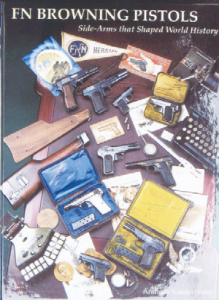Review by Larry S. Sterett Contributing Editor
FN BROWNING PISTOLS: Side- Arms that Shaped World History, by Anthony Vanderlinden. ©2009.
Published by Wet Dog Publications, 5603-B West Friendly Ave., Suite 166, Dept. TGM, Greensboro, NC 27410.
Price: $64.95, plus shipping. (Free shipping if you mention this review.) Available in some bookstores, or by phone: 336-275-0405.
This oversize 336-page hardbound volume is devoted to the most popular pistols of all times, the Brownings. (Although the Browning designed, Colt manufactured M1911 in .45 ACP has a great following, particularly in the US, the M1935 High Power in 9mm has probably seen military use by more nations than any other pistol design, with possibly the exception of the Russian Tokarev T-33.) Although not labeled as chapters, this outstanding tome features what amounts to 22 such topic sections.
These range from “The History of Fabrique Nationale” to “The Browning Arms Company Pistols.” Between, coverage is provided of the various FN models, from the 1899 to the 100 Series, in addition to such topics as “Proofs and Markings,” “The John M. Browning Prototypes,” and “FN Production Processes and Procedures.” Accompanying the text are more than 1,000 black and white illustrations.
The illustrations include not only many examples of the various models, but close-up shots providing details on slide markings, proof marks, model designations, seals, and even the checkering pattern variations and the safety markings used on the models. (On the Model 1900, for example, the safety markings were always in French [Feu, Sur], with the option of being in German [Feuer, Sicher] or English [Fire, Safe].) Many of the photographs had never appeared previously in print, and period views of Browning pistols in use are provided along with shots of instruction manuals, exploded-view charts, patent specifications, proof marks, engraving patterns, and more. (The photographs of the individual pistols are of such excellent quality it is almost like holding the respective pistol in your hand, except for being unable to turn it over.) FN produced more than rifles and shotguns, and many, if not all, of the various products are discussed and illustrated in the first, or history portion of this text. Automobiles, motorcycles, bicycles—chain-driven and chainless—milking machines, typewriters, trolley buses, tracked artillery tractors, and a number of versions of a Tricar were produced at various times. One of their motorcycles held a world land speed record of 139.25 miles per hour back in 1934, and the 1937 Tricar appears to be something that would be welcome today. (The Tricar resembled the back half of a Willys Jeep with the front half of the FN M.12 motorcycle.
Powered by a 1,000cc twin-cylinder engine which provided even traction to both rear wheels, the Tricar was produced in several versions, including fuel supply [500 liters], ammunition supply [10,000 rounds], and anti-aircraft [fitted with a .50 BMG behind the front seat] models. If it worked so well during the war, it should make an excellent ATV today.) Readers will note many Browning designs which never achieved production status, but which might, if produced for today’s market.
Among those this reviewer found particularly interesting were the 1908–1909 hammerless (concealed hammer) .45, which resembled a large version of the M1908 as produced by Colt, and the 9.65mm M1910 Grand Browning. Colt had produced a few of their M1911 pistols for a new 9.8mm Colt cartridge, but discontinued its development, while FN had the M1910 and the 9.65mm ammunition ready for production when World War I broke out. Reintroduced briefly in 1922 for French trials it was again dropped when military orders were not forthcoming.
Less than half-a-dozen years ago it was rumored the M1910 Grand Browning might yet see production.
Each of the various FN-produced pistols is covered in detail, including the Husqvarna Model 1907 manufactured in Sweden, and variations of the basic designs as required by the countries placing orders. (A minimum order for any changes was 500 pieces.) The photographs are all captioned, and footnotes, when necessary, are provided, along with many sidebars featuring related information. An example of the last is the Model 1922 Wartime Production Timeline for the period during which the FN factory was operated under German occupation.
In addition to the handguns, sights, shoulder stocks, holsters, model variations, engraving patterns and more are covered in detail in this excellent volume devoted to FN pistols. It deserves space on the reference shelf of any handgun collector, arms museum curator, handgun designer or manufacturer, or small arms devotee. It would be difficult to locate a more detailed book than this on the subject. With more than 1,000 superb illustrations, it covers about every possible variation which FN might have made since they began production of their first Browning-designed pistol in January 1899.




